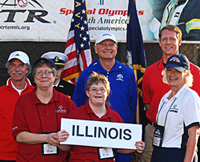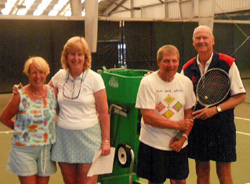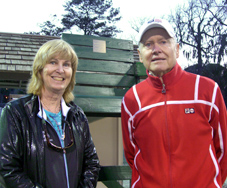ADAPTIVE TENNIS
EVERYONE CAN ENJOY TENNIS
Dennis Van der Meer’s philosophy is that everyone, regardless of circumstance, can enjoy tennis. Dennis always took a great interest in adapting tennis to suit any special needs his students may have. Being on court with Dennis was always fun for all. He adapted instruction for most temporary (as in stroke rehab,) or long term (as in intellectual disability) physically or mentally challenged populations. Part of every TennisUniversity course is devoted to information on adaptive tennis, and finding programming on the web.
Wheelchair Tennis
An early believer in wheelchair tennis instruction, Dennis worked with Brad Parks and other wheelchair tennis experts to create progressions for tennis teachers to bring the sport to athletes in chairs. As the sport evolved, many other people and organizations have contributed greatly to its development and popularity. Most countries now have national programs for competition and training through the ITF.
 Special Olympics
Special Olympics
When asked to do a clinic for people with intellectual abilities, Dennis saw immediately that there was a need for adapted instruction to enable a large population to enjoy tennis and be part of the mainstream. As tennis was added to Special Olympics, he was part of the development of the innovative curriculum and event growth. He is very proud of PTR and PTR Foundation’s long-term involvement with this organization.
Stroke Rehabilitation
Dennis developed an extensive curriculum for helping stroke and head injury survivors recover through tennis. He found that whether dealing with former players or neophytes, tennis has qualities that can trigger needed responses if taught in easy progressions. He worked with therapists in hospital settings to develop these progressions, then took it further to training programs at home.
A stroke often leaves one entire side of its victim paralyzed and/or unable to recognize its very existence. Called “neglect”, this condition is often reversible through adaptive, creative tennis exercises. These exercises can be started as soon as the patient is alert enough to respond to communication, while in the hospital, gradually increasing in challenge as the patient regains strength and mobility. Incorporate strength/balance exercises as soon as possible in addition to all normal physical therapy core exercises.

1. Bean bag progressions (IN BED)
• Toss and block with hand
• Toss and catch from front and unaffected side
• Toss from “blind” side of patient who blocks or catches, tosses back* using unaffected hand
*Patients may experience times when catching and releasing the bean bag is difficult- not to worry- with patience and gently aiding the fingers through the
motions this generally improves with repetition.

2. Balloon progressions (IN WHEELCHAIR)
• Play balloon volleyball using unaffected hand
• Play balloon volleyball with junior racket, initially choking up ½ way
3. Foam ball progressions (IN WHEELCHAIR or ANY CHAIR, INSIDE OR OUTSIDE)
• Toss foam ball to patient out of the air as a volley
• Toss foam ball with a bounce to patient’s forehand
• Toss foam ball with a bounce to backhand
• Toss foam ball in air for overhead
• Show patient how to bump the ball up and serve
• Rally with patient very predictably
Once the patient is able to stand for extended periods of time, and has enough balance to take some steps, you can work with a safety belt on court for added security. At first have the patient stand against a fence. If the patient can lean against the fence, he/she will have added confidence to reach for a ball tossed in close range. As confidence builds, with someone strong holding onto the safety belt, the patient can take some steps and move over the net. Start off close to the net.
Exercises off court need to be maintained and additional running, leg lift, stationary biking, light arm weights accelerated as possible. Practicing in a pool facilitates running. All pool work builds confidence, as buoyancy aids sense of balance. Most tennis specific exercises can be practiced in water that comes to waist level.
4. Foam ball progressions (ON COURT)
• Go through progressions mentioned in #3
• If movement improves in affected arm, begin showing modified service toss with “ice cream cone” motion. (Affected hand probably has “tone”, causing it to clench. As this improves, practice releasing the ball and tossing up)
• Serve from backscratch position, adding backswing gradually
• Rally side to side, predictably
5. Standard ball progressions (ON COURT)
• Repeat progressions in #4
• Rally using graduated length method of starting up close to the net and gradually moving back
• Play predictable points
• Add some challenge to the point play as possible
• Play controlled doubles
Some tips that really help in recovery
• Be patient yet determined
• Set goals but not timetables
• Keep your sense of humor
• Find role models in recovered stroke/accident victims
• Choose therapists willing to press beyond what’s average
• BELIEVE IN EVENTUAL RECOVERY


